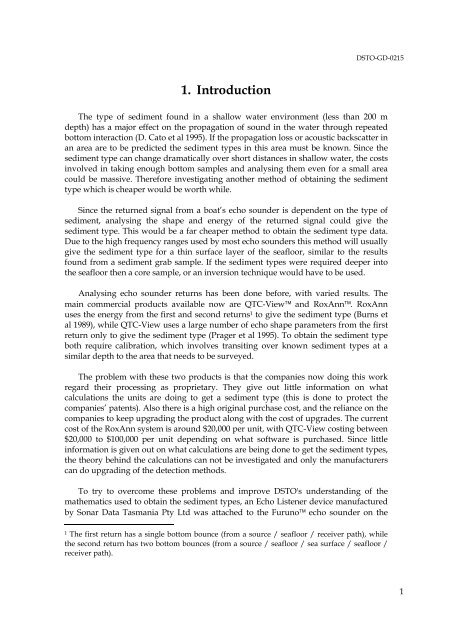The ABCS Program for the Analysis of Echo Sounder Returns for ...
The ABCS Program for the Analysis of Echo Sounder Returns for ...
The ABCS Program for the Analysis of Echo Sounder Returns for ...
You also want an ePaper? Increase the reach of your titles
YUMPU automatically turns print PDFs into web optimized ePapers that Google loves.
DSTO-GD-02151. Introduction<strong>The</strong> type <strong>of</strong> sediment found in a shallow water environment (less than 200 mdepth) has a major effect on <strong>the</strong> propagation <strong>of</strong> sound in <strong>the</strong> water through repeatedbottom interaction (D. Cato et al 1995). If <strong>the</strong> propagation loss or acoustic backscatter inan area are to be predicted <strong>the</strong> sediment types in this area must be known. Since <strong>the</strong>sediment type can change dramatically over short distances in shallow water, <strong>the</strong> costsinvolved in taking enough bottom samples and analysing <strong>the</strong>m even <strong>for</strong> a small areacould be massive. <strong>The</strong>re<strong>for</strong>e investigating ano<strong>the</strong>r method <strong>of</strong> obtaining <strong>the</strong> sedimenttype which is cheaper would be worth while.Since <strong>the</strong> returned signal from a boat’s echo sounder is dependent on <strong>the</strong> type <strong>of</strong>sediment, analysing <strong>the</strong> shape and energy <strong>of</strong> <strong>the</strong> returned signal could give <strong>the</strong>sediment type. This would be a far cheaper method to obtain <strong>the</strong> sediment type data.Due to <strong>the</strong> high frequency ranges used by most echo sounders this method will usuallygive <strong>the</strong> sediment type <strong>for</strong> a thin surface layer <strong>of</strong> <strong>the</strong> seafloor, similar to <strong>the</strong> resultsfound from a sediment grab sample. If <strong>the</strong> sediment types were required deeper into<strong>the</strong> seafloor <strong>the</strong>n a core sample, or an inversion technique would have to be used.Analysing echo sounder returns has been done be<strong>for</strong>e, with varied results. <strong>The</strong>main commercial products available now are QTC-View and RoxAnn. RoxAnnuses <strong>the</strong> energy from <strong>the</strong> first and second returns 1 to give <strong>the</strong> sediment type (Burns etal 1989), while QTC-View uses a large number <strong>of</strong> echo shape parameters from <strong>the</strong> firstreturn only to give <strong>the</strong> sediment type (Prager et al 1995). To obtain <strong>the</strong> sediment typeboth require calibration, which involves transiting over known sediment types at asimilar depth to <strong>the</strong> area that needs to be surveyed.<strong>The</strong> problem with <strong>the</strong>se two products is that <strong>the</strong> companies now doing this workregard <strong>the</strong>ir processing as proprietary. <strong>The</strong>y give out little in<strong>for</strong>mation on whatcalculations <strong>the</strong> units are doing to get a sediment type (this is done to protect <strong>the</strong>companies’ patents). Also <strong>the</strong>re is a high original purchase cost, and <strong>the</strong> reliance on <strong>the</strong>companies to keep upgrading <strong>the</strong> product along with <strong>the</strong> cost <strong>of</strong> upgrades. <strong>The</strong> currentcost <strong>of</strong> <strong>the</strong> RoxAnn system is around $20,000 per unit, with QTC-View costing between$20,000 to $100,000 per unit depending on what s<strong>of</strong>tware is purchased. Since littlein<strong>for</strong>mation is given out on what calculations are being done to get <strong>the</strong> sediment types,<strong>the</strong> <strong>the</strong>ory behind <strong>the</strong> calculations can not be investigated and only <strong>the</strong> manufacturerscan do upgrading <strong>of</strong> <strong>the</strong> detection methods.To try to overcome <strong>the</strong>se problems and improve DSTO's understanding <strong>of</strong> <strong>the</strong>ma<strong>the</strong>matics used to obtain <strong>the</strong> sediment types, an <strong>Echo</strong> Listener device manufacturedby Sonar Data Tasmania Pty Ltd was attached to <strong>the</strong> Furuno echo sounder on <strong>the</strong>1 <strong>The</strong> first return has a single bottom bounce (from a source / seafloor / receiver path), while<strong>the</strong> second return has two bottom bounces (from a source / seafloor / sea surface / seafloor /receiver path).1
















